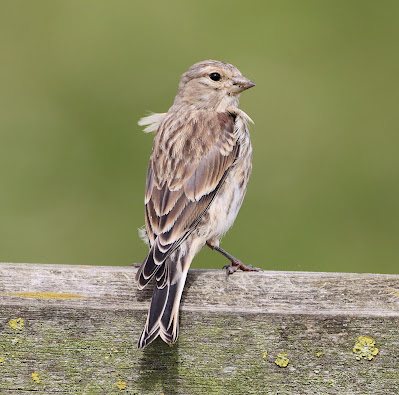The Hobby is still something of a scarcity in this part of coastal Lancashire known as The Fylde. The sighting of a Hobby adds more than a smidgeon of excitement to an often mundane day. Even better when a single sighting of the will o’ the wisp raptor becomes a double whammy.
The Hobby, a Schedule One Species, breeds inland not too many miles away, just a car ride away, a location already subject to interest from too many bird listers. It would be easy to add to the database of visitors and potentially draw attention to a breeding locality but how much better is it to meet and to enjoy a Hobby or two in the course of a normal day's birding?
My latest encounter of this pacy raptor came about today while Andy and I were out bird ringing over Pilling way, catching the bits and pieces of a normal day. A quiet spell had us sitting in the sun watching Meadow Pipits surveying a walk-in trap placed about 40 yards away on the farm track. We’d had some success with eight Meadow Pipits caught but frustrated by the sight of two Yellow Wagtails not finding their way into the metal maze while pipits had no such problems.
From the north and east came two Hobby (is that Hobbys or Hobbies?) in close unison, playing in the breeze like the juveniles they were as they drifted over the nearby sea wall and continued their leisurely way west. It was yesterday evening when the farmer Richard told me of his sighting while tending livestock of a “large swift” - “going like the clappers”, one of those sightings that goes into the memory hole to often resurface another day.
We caught other species in a single, slightly blowy mist net and ended up with 14 ringed – 8 Meadow Pipit, 3 Sedge Warbler, 1 Reed Warbler, 1 Whitethroat and 1 Pied Wagtail.
Meadow Pipit
Reed Warbler
Whitethroat
Pied Wagtail
Birds that got away or didn’t come near the nets included 70 or more Swallows,40 Meadow Pipits, 4 Wheatear, 25 Pied Wagtail, 4 Yellow Wagtail, 8 Goldfinch, several Linnets, Grey Heron, Common Sandpiper.
Linnet
Wheatear
Wheatear
Goldfinch
Yellow Wagtail
Swallow
Swallow
Yes, it was a very young Wheatear that has quickly joined in the action, already setting off on the long journey to Africa.
While the sun shines I’m making hay too.
Weekend is not looking good but two more days of bright weather means more news, views and photos on Another Bird Blog. Don't miss it folks.
Linking today to Eileen's Saturday Blog.






































.jpg)












